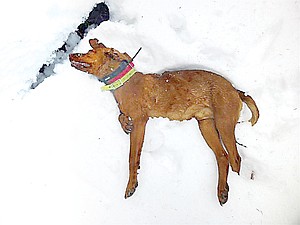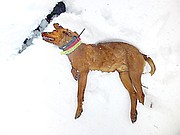Wolves kill three hounds
Ryan Murray | Hagadone News Network | UPDATED 12 years, 10 months AGO
Edit: The previous edition of this story stated that Roy, Soucy's 10-year-old dog, was a beagle. Roy was an English coonhound, a larger dog used for hunting. The Western News regrets this error.
A thrilling hunt ended in the worst way for several local cat-hunters, as a harrowing night led to an expected and sad end.
Three hounds set loose in wild country by their owners to tree a mountain lion were never again seen alive by their owners.
Their owners, Phil Soucy, Clyde Carpenter and Todd Hittle, were chasing the cat between Flower and Parmenter creeks, just two miles from the edge of Woodway Park on Saturday, Feb. 2.
The hunters circled the area to look for fresh wolf tracks heading in the direction they wanted to free the hounds and finding none, deemed it safe for the dogs.
They were wrong.
“Initially, this has been one of my greatest fears,” Soucy said. “When you turn your dogs loose, it takes the fun right out of it. It turns my stomach in knots.”
The three dogs, Sadie, Dan and Roy, were killed by wolves shortly after they were set loose, Soucy estimates. The bodies of the dogs were recovered the next day.
Roy, Soucy’s 10-year-old English coonhound, and the “best male dog he ever had,” was the last dog killed and was actually fed upon by the wolves.
“I couldn’t take the collar off Roy,” he said. “I just couldn’t do it. It was too hard for me.”
Incidents like this occur once or twice a year, said Jerry Mercer, taxidermist and hunter.
“Trapping isn’t going to be enough,” Mercer said. “Increasing the number of tags is milquetoast. We can’t use snares. Talk to any wolf hunter in Alaska or Canada and they’ll tell you snares are how they catch wolves.”
According to the 2011 wolf population and distribution map detailed by Fish, Wildlife & Parks, the pack likely responsible was either the Cabinet or Satire pack, two packs south of Libby.
The 2012 report is expected to add five to seven packs to that map in Northwest Montana, said Kent Laudon, FWP wolf biologist, bringing the number in the area near 60. With an average number of seven wolves per pack, the estimated number of wolves in Northwest Montana hovers near 420. Statewide that number is near 650.
Soucy, an experienced cat hunter who had been in every drainage in Lincoln County, says that number is, at best, a low estimate and, at worst, false information.
“Within a 25-mile radius of Libby, there are at least 75 wolves,” Soucy said. “There is a sleeper cell in every one of these drainages. Cat hunters have a far better grasp of what is out there than FWP.”
For some local officials, the signs were there, but no proof the numbers were higher than expected.
“It seems I hear about wolves all the time,” said Phil Kilbreath, Troy game warden. “I see tracks all the time, but I’ve only ever seen one. I only deal with wolves when someone harvests one.”
Jason Fosgate, firearms department manager at Mac’s Market, says reported interaction with wolves is actually down.
“I think the wolves are learning,” he said. “Those are smart animals. Hunting success is way down. They are staying away from people.”
FWP has knowledge of trends and patterns, but hunters feel the actual information is lacking.
“We only have a fraction of the packs collared,” said Jim Williams, wildlife manager at the Kalispell office of FWP. “We only track those that threaten livestock.”
This fact was not lost on the hunters.
“They do not recognize a wolf pack unless they have one collared,” Soucy said. “They only just now recognized the Bearfite pack up in Pipe Creek.”
With open-season for wolves in Region 1 (Lincoln, Flathead and Lake counties, not counting the Flathead Reservation) hunters and trappers are allowed to get three wolves per license. One shot and two trapped or three trapped wolves are the combinations allowed for the wolves.
For the hunters who lost their hounds, something needs to be done.
“I think we’ve got way too many wolves,” said Carpenter, owner of 6-year-old Dan, a Redbone Coonhound named after Old Dan from Where the Red Fern Grows. “Traps and bullets, I don’t believe are going to do much.”
The third dog, Sadie, a Bluetick Coonhound, actually belonged to Hittle’s 14-year-old son Ryker.
Wolves began recolonizing Northwest Montana in the early 1980s, and despite slow growth for nearly two decades, have grown by at least 20 percent every year since 2004, when the state population of wolves was just 150.
Williams said although there are packs “undoubtedly” unaccounted for, the rhetoric needs to calm down about the number of wolves.
“The population is not increasing in density, just expanding to new territory,” Williams said. “It’s impossible to use tracks to estimate numbers of packs. These aren’t like cougars, wolves are very mobile.”
Laudon, the area wolf expert, says a wolf pack typically has a territory of 200-square miles and is capable not only of splitting up into separate hunting parties, but of traveling seven miles or more every day.
This makes it a roll of the dice, he said.
“I think that most to all of our hunters in this area are pretty savvy in letting dogs loose in wolf country,” Laudon said. “These hunters can spot lion tracks going 35 mph, and wolves tend to be much more ‘sign-y’ than lions.”
For Soucy, who understands the risks inherent in cat-hunting, the wolves have become more trouble than they are worth.
“They make coyotes look stupid,” he said. “Only one person in Lincoln County has caught more than one wolf this season.”
In Wolf Management Unit 100, which comprises Libby, Troy and the Yaak, the total harvest of wolves has been just 14.
“I think the only solution is to give them predator status,” Soucy said. “Lift all restrictions. There is tremendously high pup survival. Territories are getting smaller and smaller. Gone are the days of leaving your dogs out overnight.”
FWP only tracks the packs that threaten livestock. For packs that do attack livestock, the wolves are lethally removed.
There are no laws removing wolves or compensation for lost pets like there is mitigation for livestock.
“Nothing happens,” Laudon said. “There has never been any kind of action for that.”
Montana is home to a “defense of property” statute, which allows for legal defense of livestock or pets. Any wolves involved in such attacks need to be reported within 72 hours of the attack.
An incident like the deaths of Dan, Roy and Sadie happens once or twice a winter, Williams said.
“What’s next?” asks Carpenter. “Is it going to be the snowshoer and his dog? The cross-country skier?”
While the attack is an emotional one, the FWP officials caution restraint and proper safety.
“Many types of pets are vulnerable to coyote and wolf confrontations in the woods,” Williams said. “It is a risk. Pay attention to the signs.”
ARTICLES BY RYAN MURRAY

Eureka brewery turns heads with IPA
Off the beaten path, not far from the Canadian border, intrepid beer drinkers can find the best India Pale Ale in Montana — or at least the best according to the Montana Brewers Association.

Prep Tennis: Trojans romp at Bigfork tourney
The Trojan tennis teams crushed Valley Christian last Thursday 5-1 for the girls and a 6-0 sweep for the boys on their way to the Bigfork Tennis Tournament.
W.F. Morrison principal is fired; no reason given by board
In a surprising unanimous vote last Monday, the Troy School Board decided not to renew the contract of W.F. Morrison Principal Kelly Moore.



